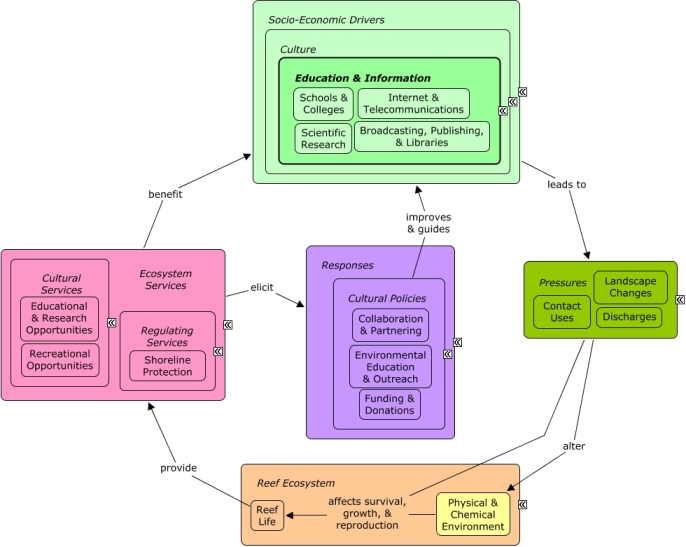ReefLink Database

Broadcasting, Publishing, & Libraries
Broadcasting, Publishing, and Libraries sectors include the preparation, distribution or sale, and storage of written, visual, and spoken content in print or on television, radio, or motion pictures (NAICS 2007).
CMap

CMap Description
Growing coastal development changes the cultural identity of a community, creating an increased need for education and information. Infrastructure is needed to support the Education and Information sectors, including buildings and roads, and this infrastructure results in landscape changes and discharges. Information sectors may benefit from aesthetic value provided by reefs, including photography and video. Coastal schools & colleges may also directly benefit from shoreline protection. Reef ecosystems also provide educational and research opportunities for students and scientific researchers. Scientific research can contribute to the effectiveness of decisions by enhancing our understanding of ecosystems. Collaboration and funding can improve, increase, and guide scientific research. Decision-makers may also utilize schools & colleges to improve environmental education.Citations
More than 50 citations. Click here to load.
| Citation | Year | Study Location | Study Type | Database Topics |
|---|
Management Options
| Management Option | Description | Sources | Database Topics |
|---|---|---|---|
| Administrative & Interagency Policy: Provide Policy Information to the Public | Communicate valid and emerging resource concerns to the general public. This can be accomplished through (#106), (#), or (#). | NOAA Marine Sanctuary Program. 2007. Florida Keys National Marine Sanctuary revised management plan. National Ocean Service, Key West, FL. |
Broadcasting, Publishing, & Libraries; Cultural Policies; Culture; Education & Information; Environmental Education & Outreach; Infrastructure; Internet & Telecommunications; Responses; Schools & Colleges; Scientific Research; Sectors Filling Human Needs; Socio-Economic Drivers; Utilities |
| Data Management & Decision Tools: Conduct a Modeling Workshop | Conducting a workshop can be useful to discuss modeling approaches, develop preliminary conceptual models, and define specific information needs for models. There are decision tools to choose from other than traditional models, and many different modeling approached to choose from, making this type of workshop both an outreach effort, and an effort to collaborate. | NOAA Marine Sanctuary Program. 2007. Florida Keys National Marine Sanctuary revised management plan. National Ocean Service, Key West, FL. |
Broadcasting, Publishing, & Libraries; Collaboration & Partnering; Cultural Policies; Culture; Decision Support; Education & Information; Environmental Education & Outreach; Physical & Chemical Environment; Reef Life; Scientific Research; Sectors Filling Human Needs; Socio-Economic Drivers |
| Develop & Distribute Educational Materials: Provide Interpretive Information | Targeted information should be provided and interpreted for media, interest groups, periodicals, publications, and environmental organizations. This information may be about available programs/resources, research findings, policy changes, statistics, avoidance techniques, legal/financial consequences etc. This information should be provided specifically for these groups in such a way to best enhance public understanding regarding reef resources. It is important to interpret this information for these user groups, as this will help them convey the often technical information to the public. | NOAA Marine Sanctuary Program. 2007. Florida Keys National Marine Sanctuary revised management plan. National Ocean Service, Key West, FL. |
Broadcasting, Publishing, & Libraries; Collaboration & Partnering; Decision Support; Education & Information; Environmental Education & Outreach; Scientific Research; Security & Public Administration Policies |
| Dissemination of Findings: Report Monitoring and Research Results | It is important to disseminate data and information gathered to collaborators and the wider scientific community. This can be accomplished through publication, such as journals (#161) or other networks (#159). It is important to share this data with other government agencies as well (#92). | NOAA Marine Sanctuary Program. 2007. Florida Keys National Marine Sanctuary revised management plan. National Ocean Service, Key West, FL. |
Biological Monitoring & Restoration; Biological Monitoring, Mapping, & Scientific Research; Broadcasting, Publishing, & Libraries; Collaboration & Partnering; Cultural Policies; Decision Support; Ecosystem Monitoring & Restoration; Education & Information; Educational & Research Opportunities; Environmental Education & Outreach; Environmental Monitoring & Restoration; Environmental Monitoring, Mapping, & Scientific Research; Scientific Research; Security & Public Administration Policies |
| Injury Prevention: Assist Education and Outreach | This plan is to help prevent groundings. This can be achieved through providing products and information such as statistics, avoidance techniques, and legal/financial consequences. Such information would be provided for media, interest groups, periodicals, publications, and environmental organizations. | NOAA Marine Sanctuary Program. 2007. Florida Keys National Marine Sanctuary revised management plan. National Ocean Service, Key West, FL. |
Anchoring & Vessel Grounding; Boating Activities; Broadcasting, Publishing, & Libraries; Contact Uses; Cultural Policies; Culture; Dredging Regulations; Ecosystem Monitoring & Restoration; Education & Information; Environmental Education & Outreach; Environmental Monitoring & Restoration; Physical Damage; Pressures; Resource Use Management; Responses; Sectors Filling Human Needs; Socio-Economic Drivers |
| Restoration: Work with public outreach coordinator to inform the public about habitat restoration activities | This response involves restoration teams providing information, photos, and videos to be used in press release, TV and radio, and magazine articles to inform the public about restoration projects for corals. | NOAA Marine Sanctuary Program. 2007. Florida Keys National Marine Sanctuary revised management plan. National Ocean Service, Key West, FL. |
Biological Monitoring & Restoration; Broadcasting, Publishing, & Libraries; Cultural Policies; Culture; Ecosystem Monitoring & Restoration; Education & Information; Environmental Education & Outreach; Infrastructure; Internet & Telecommunications; Responses; Sectors Filling Human Needs; Socio-Economic Drivers; Utilities; Wetland & Reef Restoration |
Laws
| Legal Citation | Purpose of Law | Management Organization | Database Topics |
|---|
